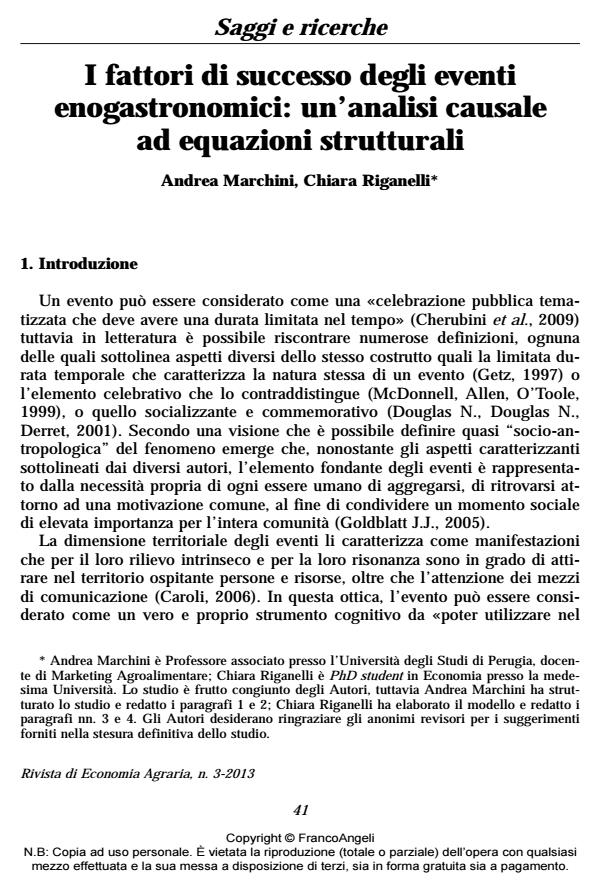The success factors of food and wine events: a causal analysis using structural equations
Journal title RIVISTA DI ECONOMIA AGRARIA
Author/s Andrea Marchini, Chiara Riganelli
Publishing Year 2014 Issue 2013/3
Language Italian Pages 23 P. 41-63 File size 284 KB
DOI 10.3280/REA2013-003003
DOI is like a bar code for intellectual property: to have more infomation
click here
Below, you can see the article first page
If you want to buy this article in PDF format, you can do it, following the instructions to buy download credits

FrancoAngeli is member of Publishers International Linking Association, Inc (PILA), a not-for-profit association which run the CrossRef service enabling links to and from online scholarly content.
The objective of the study is to examine the complexity of the factors that determine the success of food and wine events. After surveying evidence on "event marketing", the authors have formulated hypotheses for a causal model and have collected data during the "Frantoi Aperti" ("Open Oil Presses") event in the Region of Umbria. Participants were interviewed and asked to express opinions about the importance and the interest of certain aspects directly linked to the theme of the event and, ultimately, to evaluate their level of satisfaction and their likely behaviour in the future. Statistical analysis based on a structural equation model allowed the authors to demonstrate which aspects are significant in confirming the hypotheses formulated. The results provide indications for choices concerning organization and management of the food and wine event.
Lo scopo dello studio è quello di individuare la complessità dei fattori che determinano il successo di un evento enogastronomico. Gli Autori, dopo richiami sullo stato dell’arte dell’event marketing, formulano le ipotesi di un modello causale ed effettuano una raccolta dati durante la manifestazione "Frantoi Aperti" della Regione Umbria. Attraverso interviste in profondità è stato chiesto ai partecipanti di esprimersi circa l’importanza e l’interesse attribuito ad alcuni aspetti direttamente collegati al tema dell’evento, e di indicare infine il grado di soddisfazione e la probabilità di alcuni loro comportamenti futuri. Un’analisi statistica fondata su modelli ad equazioni strutturali ha permesso agli Autori di evidenziare quali aspetti risultano significativi al fine di confermare le ipotesi formulate. I risultati forniscono indicazioni per le scelte di gestione ed organizzazione dell’evento enogastronomico.
Keywords: Event marketing, tourism, extra virgin olive oil, Umbria, Food&Wine festival, SEM
Jel codes: C30, O18, M20
Andrea Marchini, Chiara Riganelli, I fattori di successo degli eventi enogastronomici: un’analisi causale ad equazioni strutturali in "RIVISTA DI ECONOMIA AGRARIA" 3/2013, pp 41-63, DOI: 10.3280/REA2013-003003